Discover the top 16 activities and must-see attractions in Erfurt, a hidden gem nestled in the heart of Germany with a charm that whispers tales from the Middle Ages through to the modern day. This guide will be your compass to the city’s finest experiences, from historical wonders to contemporary delights.
Often ignored by foreign tourists, Erfurt offers a lot for those that make the small amount of effort to come here. As soon as I arrived in the Old Town of Erfurt and wandered through the cobblestone streets, it quickly became one of my favorite places in Germany. Then I saw Cathedral Hill and walked across Krämerbrücke (Merchant’s Bridge) and I was fully in love with Erfurt. 😍
I love the atmospheric Old Town, the history, everything really!
And whether you’re peering up at the awe-inspiring spires of the Erfurt Cathedral or walking across the famed Krämerbrücke, a sense of wonder is guaranteed.
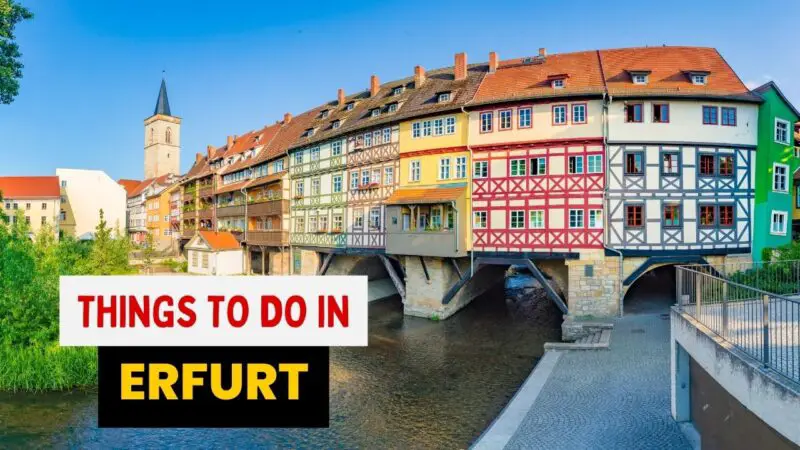
While the city skilfully honors its past, it also embraces the present with lively cafes, boutique shops, and a buzzing atmosphere that invites you to dive in and explore.
In a city brimming with rich history and picturesque views, pinpointing the very best things to do in Erfurt can be a delightful challenge. That’s precisely why I’ve curated this list, featuring a combination of well-loved classics and hidden treasures that are as intriguing as they are accessible.
Ready to uncover the historical heart of Germany? Let’s step into the story that is Erfurt, one extraordinary experience at a time.
Love Germany? Click here to download your free guide to ALL of Germany’s Amazing UNESCO sites. See all 52 of them!
A Brief History of Erfurt
Erfurt, the capital city of the state of Thuringia in central Germany, boasts a rich and varied history that stretches back over a millennium. Its origins can be traced back to the prehistoric era, but the city’s significant development began with its establishment in the early Middle Ages.
Erfurt was first mentioned in 742 AD by Saint Boniface, the famed missionary who considered it an ideal site for spreading Christianity. The city’s advantageous position at the intersection of old Germanic and European trade routes, most notably the Via Regia, which connected Eastern and Western Europe, fostered its rapid growth and importance as a commercial hub.
The establishment of a bishopric in the 8th century further elevated Erfurt’s status, and by the 10th century, the city was a prominent religious center. The construction of the Erfurt Cathedral and the Severikirche, both perched on the Cathedral Hill, encapsulate the city’s medieval ecclesiastical significance.
The Middle Ages saw Erfurt rise to prominence as a center of learning and enlightenment. The University of Erfurt, founded in 1379, is one of the oldest universities in Europe. It became a cradle of humanist thought during the Renaissance with notable scholars, including Martin Luther, who studied there in the early 16th century.

This intellectual heritage was integral in shaping Reformation ideas that would sweep across Europe.
During its history, Erfurt has faced many turbulent periods including the Peasants’ War in 1525 and the Thirty Years’ War from 1618 to 1648, which brought about much destruction. However, the city continued to thrive economically due to its production of woad, a plant used for blue dye, which was a highly prized commodity in Europe.
The modern industrial era introduced railway manufacturing and other industries to Erfurt, further securing its economic relevance. During World War II, the city suffered damage, although less extensive compared to other German cities. In the post-war period, Erfurt became part of the German Democratic Republic (East Germany) until the reunification of Germany in 1990.
After reunification, Erfurt underwent substantial preservation and restoration efforts to revive its historical buildings and cultural heritage. Today, it is known for its well-preserved medieval city center, the renowned Krämerbrücke (Merchant’s bridge), and as a vibrant cultural location that honors its multifaceted past while looking towards a dynamic future.
Top 16 Incredible Things To Do In Erfurt

The first 12 Erfurt attractions in the list are in Erfurt itself. The next three are half or full day trips you can make from Erfurt.
Something I really loved about staying in Erfurt was the easy access to some great other towns in Germany that are well worth the day trip. So consider doing them!
1. Erfurt Cathedral and St. Severus Church (Erfurter Dom und Severikirche)
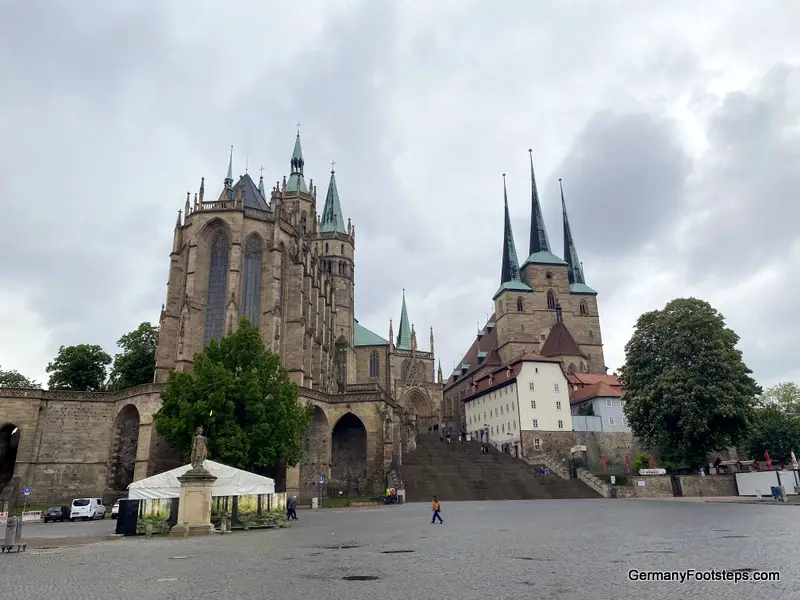
Situated on a hill, Domberg (Cathedral Hill) that really shows off the majesty of these churches, the Cathedral of St. Mary and the St. Severus Church are jewels of Gothic architecture and the spiritual center of the city.
I got a shock when I turned a corner and saw these churches looking over me from the massive Domplatz.
The cathedral started its life in the 8th century as a simple cathedral and now is a stately Gothic church most famous for being where Martin Luther was ordained as a priest.

It boasts the world’s largest free-swinging medieval bell, the Maria Gloriosa. You can marvel at the cathedral’s stunning stained glass windows and check out the Wolfram, an 850 year old candelabrum.
In the adjacent St. Severus Church, the three naves speak volumes about its architectural evolution since the late 13th century. It’s home to some treasures too including the sarcophagus of St Severus which was brought here from Ravenna via Mainz in the 9th century.
Together, they offer not just a historical and religious excursion but a remarkable architectural journey as well.
2. Amazing Squares
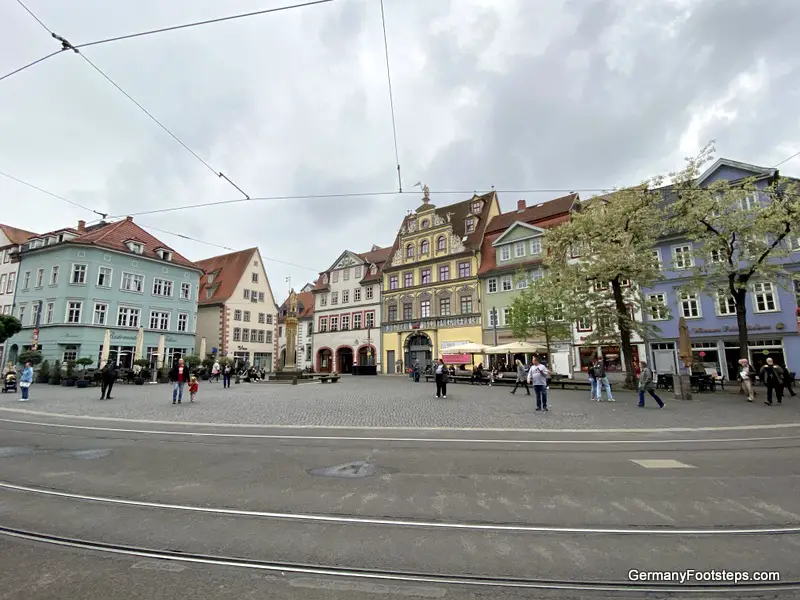
Exploring the historic quarters of Erfurt is like leafing through the pages of time. The main squares such as Domplatz, the site of the magnificent Erfurt Cathedral, Anger, Wenigemarkt, and Fischmarkt are hubs of public life, surrounded by traditional and Renaissance buildings.
Domplatz is particularly notable for hosting events like the Christmas market under the watchful eyes of Erfurt Cathedral and St. Severus Church.
Anger, once a medieval trade and processions route, now basks in its evolution as a modern shopping haven.
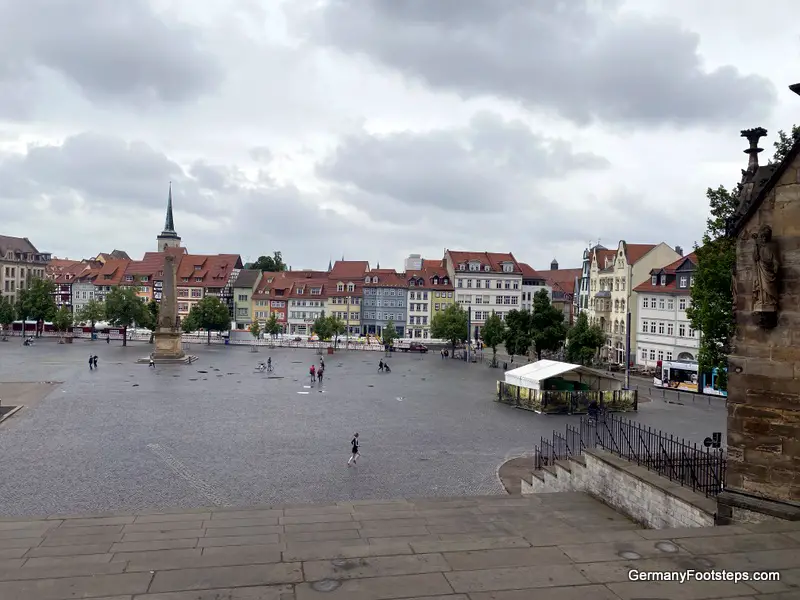
Wenigemarkt, with its quaint cafés and crafts shops, offers an intimate town square feel, while Fischmarkt, the political center, is home to the neo-Gothic Erfurt Town Hall as well as many other stunning buildings. These squares are living museums, perfect for travelers seeking to touch the city’s heartbeat.
I recommend you wander between these, soaking up the Old Town atmosphere and visiting other attractions in Erfurt on this list.
3. Merchant’s Bridge (Krämerbrücke)

Krämerbrücke is one of Erfurt’s architectural marvels – a bridge not only traversed by people but inhabited by them. Its history dates back to the 12th century, though its current appearance was formed in the 16th century.
With its continuous row of half-timbered houses on both sides, the bridge has a lively micro-community feel, hosting art galleries, cafés, and antique shops that maintain the historical charm of this medieval marvel.

This really must be one of the most charming places in the world. It seemingly goes on and on with so much beauty and things to look at. Don’t believe me? Here’s just a short section:
It’s the only bridge north of the Alps that’s still inhabitated with people living above the small shops.
At the eastern end of the bridge is a small church with a tower you can climb for views from above (coming up next!).
Strolling across Krämerbrücke is a must-do Erfurt attraction for the atmospheric experience it offers. You can savor traditional Thuringian cuisine, purchase unique handcrafted souvenirs, and immerse themselves in a living piece of history that encapsulates the merchant spirit of old Erfurt.
4. St Aegidien Church (Ägidienkirche )
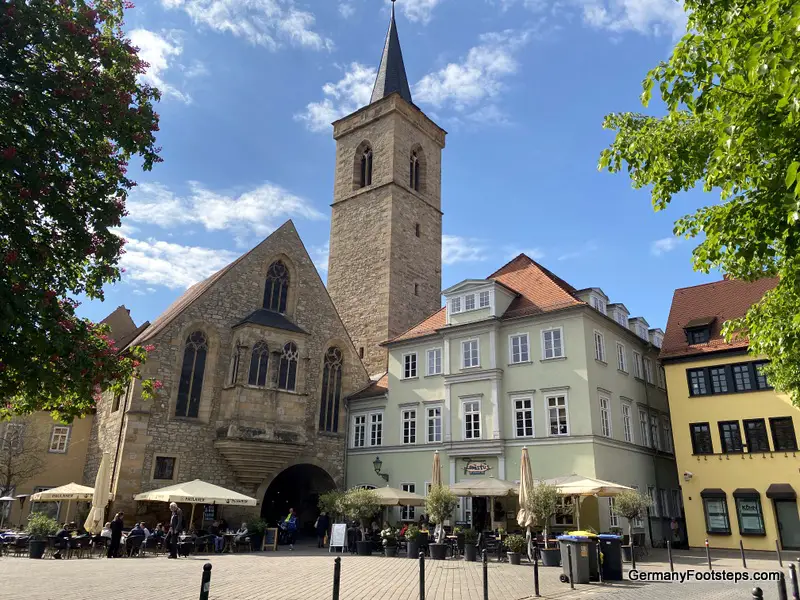
Where you enter the bridge from Wenigemarkt you actually go under this church. From underneath, there is a door to take you up to the church level.
From here, you can pay to climb the tower pictured for pretty views of the bridge and Erfurt.

It’s not the longest tower climb so it’s relatively easy. It’s worth it for the views!
Even if you don’t want to climb up the tower, go up the stairs to the church level and you can see the bridge’s shop and road from above here too. It’s super pretty!
5. Petersberg Citadel (Zitadelle Petersberg)
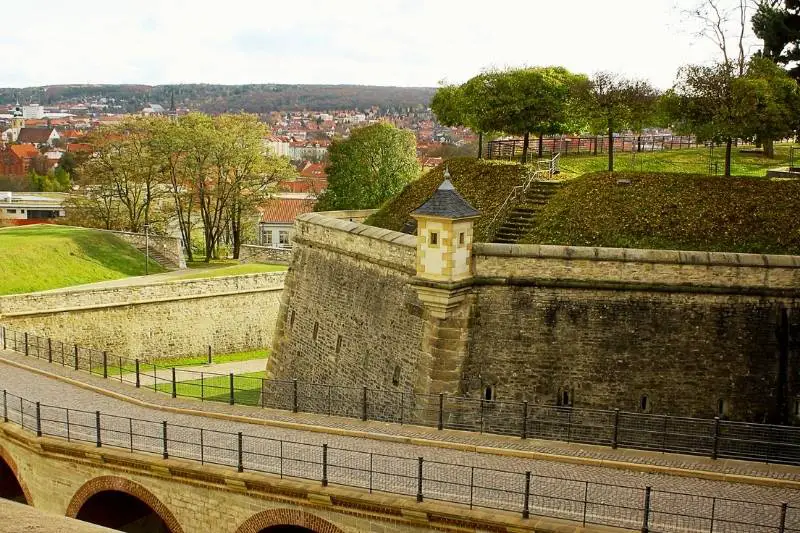
Petersberg Citadel, a breathtaking example of European baroque military architecture, reigns as a formidable structure reflecting Erfurt’s historical strategic relevance. It’s one of Europe’s best preserved and largest baroque fortresses.
Built in the 17th century atop Petersberg hill, it represents centuries of military history, with its intact bastions, casemates, and underground passages. The citadel not only tells tales of military prowess but also offers a peaceful park landscape, giving stunning elevated views of the city.
The Citadel’s ingenious design and the panoramic views of Erfurt’s timeworn treasures it provides make it a must-visit for history enthusiasts and photographers alike. There’s also a fun “ERFURT” sign.
Most buildings are closed, but there are regular tours of the underground tunnels in German. You can also wander the grounds for free.
6. Old Synagogue (Alte Synagoge)

The Old Synagogue in Erfurt is an emblem of endurance, surviving centuries of varied history. As one of the oldest synagogues in Europe, established around the late 11th century, it has witnessed Erfurt’s Jewish community’s highs and lows.
The synagogue was inadvertently protected over the ages as it was built over and forgotten after the Black Death pogrom in 1349.
It now serves as a museum displaying pieces such as the Erfurt Treasure—a collection of coins, goldsmith’s work, and Gothic hallmarks—and the Erfurt Hebrew Manuscripts. You get to engage with an ancient history that is fundamental to understanding the diverse cultural fabric of medieval Europe, making the Old Synagogue an invaluable historical visit.
Combined with the Mikveh, and the Stone House in Erfurt, this is a UNESCO World Heritage listed site.
7. St. Michael’s Church (Michaelskirche)

The magnificent St. Michael’s Church (Michaelskirche) offers an insightful peek into Erfurt’s ecclesiastical heritage.
This church dates back to the late 12th century and is home to an organ from 1652. It was a key place for protestants in the 16th century and for people towards the end of the German Democratic Republic.
It’s a beautiful church which is well worth a peak.
8. Augustinian Monastery (Augustinerkloster)
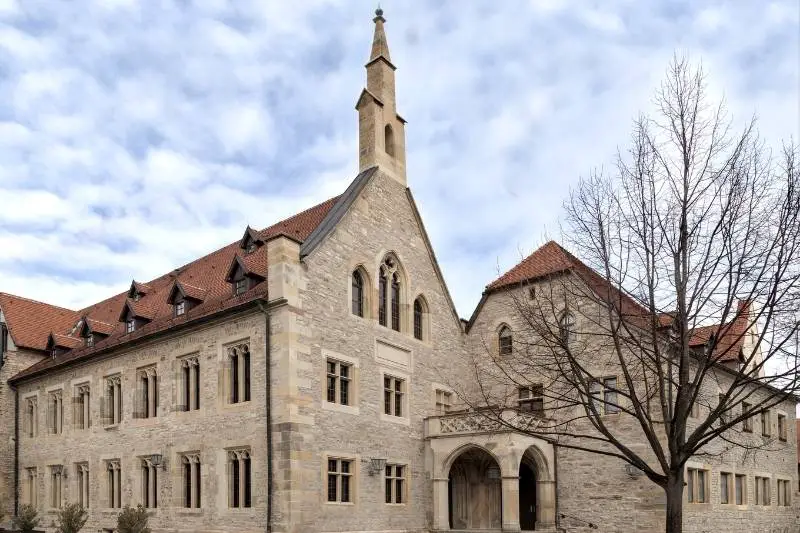
For anyone interested in history, particularly the Reformation and Martin Luther, you won’t want to miss visiting this one of the things to do in Erfurt.
The Augustinian Monastery was home to Martin Luther from 1505 to 1511. It’s where he was ordained as a monk and read his first mass.
Today, the monastery is an oasis for reflection and houses a museum that offers insights into Luther’s life, showcasing original artifacts from his time as well as a re-created Luther cell. The monastery also still hosts services in its Gothic stained-glass window church and you can roam the grounds and attend a service.
Unfortunately, you can only visit the museum and cell as part of a German language tour. You can visit the church individually.
9. “Little Venice” (Venedig)

Adorning the banks of the Gera River, the “Little Venice” area is a green and peaceful part of Erfurt. While not reminiscent of the famed Italian city at all, it does have gentle waterways and nice parkland as well as walking and biking paths.
This enclave of greenery provides a tranquil contrast to the city’s bustling centers. Here, you can enjoy the simple pleasure of a waterside stroll, offering a chance to unwind and soak in the serene atmosphere.
10. Museum of Thuringian Folklore (Museum für Thüringer Volkskunde)
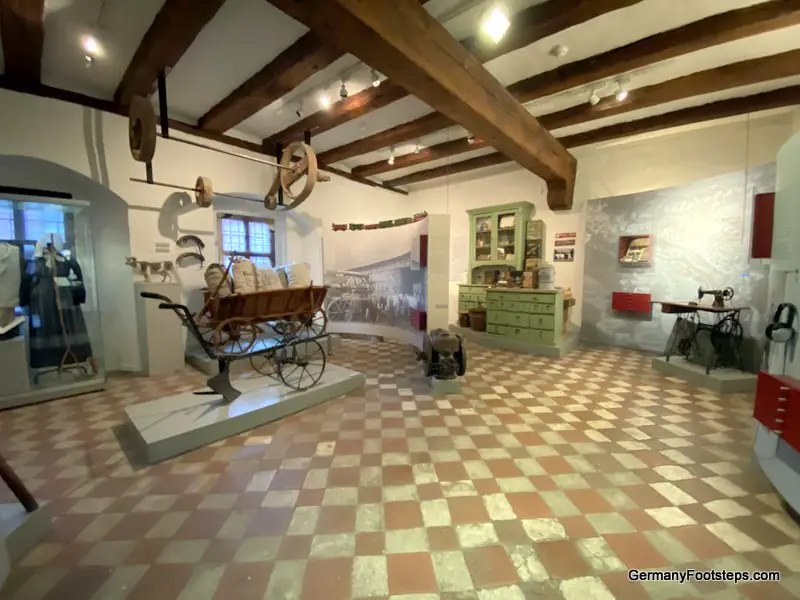
The Museum of Thuringian Folklore is a celebration of local culture, exhibiting a rich array of traditional artifacts, textiles, and crafts that paint a colorful picture of rural life in Thuringia throughout history. It’s one of the largest of its kind in Germany.
It provides a detailed narrative of everyday life, folk traditions, and the regional identity that has shaped the people of this area. Located in a former hospital director’s house, the museum itself is a part of the story, adding an authentic backdrop to the impressive collections.
You can leave with a deeper understanding of the customs, artistry, and historical lifestyle that are integral to Thuringia’s cultural heritage.
I found I learned a lot in this museum, but it’s worth noting that it’s only in German. I used my phone and Google Translate a lot, which was annoying but did the job.
11. City Museum (Stadtmuseum)

Housed in the late-Renaissance Haus zum Stockfisch, the City Museum stands as a guardian of Erfurt’s cultural narrative. Its exhibitions detail the city from its early settlement days through to life under Nazism and socialism to the present, presenting numerous artifacts, documents, artworks, and interactive displays.
Key parts of the collection relate to Erfurt’s university, its economic history as a trading center, and its urban development. Each themed area within the museum helps stitch together a cohesive and comprehensive tapestry of what makes Erfurt historically significant.
The museum, through its engaging storytelling, ensures every visitor cultivates a stronger connection with the city’s past and its evolving identity. This museum also has a lack of English.
12. Angermuseum
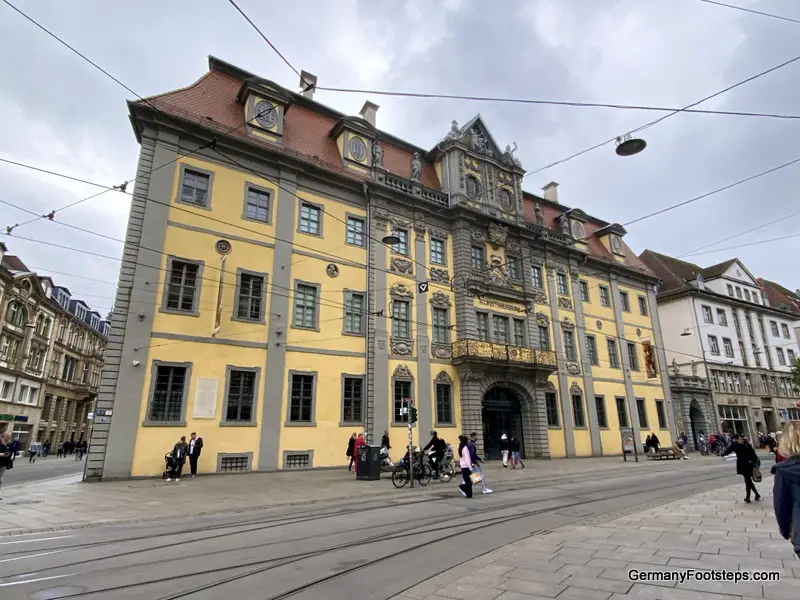
The Angermuseum, Erfurt’s main art museum, graces a former baroque city palace and serves as a custodian of Thuringian art and cultural history. Its vast collection spans from the medieval period to contemporary art, with an emphasis on medieval panel paintings and early modern art.
This historical repository impresses with the Erfurt Picture Atlas, remarkable works of the Middle Ages, and vibrant modern exhibitions. The architecture of the museum itself, with its vaulted ceilings, adds to the atmosphere, embodying the art it protects.
A haven for art lovers, the Angermuseum offers an insightful perspective on the cultural evolution of Erfurt and Thuringia through its creative expressions.
13. Egapark Erfurt and the German Horticultural Museum (Deutsches Gartenbaumuseum)
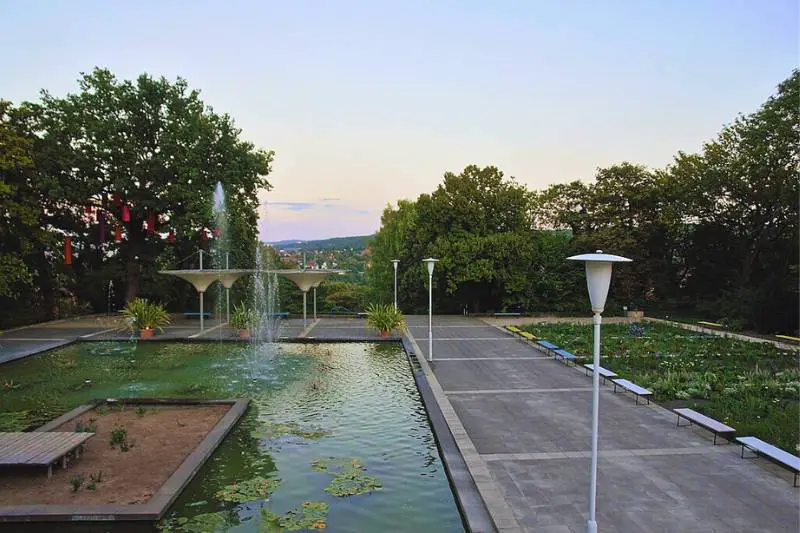
Egapark Erfurt serves as a verdant retreat spread over a vast expanse, considered one of the largest in Germany. It’s a horticultural paradise, providing an array of sensory experiences throughout its meticulously maintained gardens.
From the fragrance-filled rose garden to the largest ornamental flowerbed in Europe, each section of the park is designed to showcase the diversity and beauty of flora through thematic landscaping. The butterfly house enchants with its array of colorful species fluttering amidst tropical plants.
The park also hosts the German Horticultural Museum, located within the historic Cyriaksburg Citadel. This museum is wholly dedicated to the art and craft of horticulture, featuring exhibitions that trace gardening history from antiquity to the present.
It houses a sweeping collection of historic gardening tools, books, and models, providing you with a detailed look at how gardening science and styles have evolved over time.
Together, they offer a living gallery that educates, inspires, and delights. The blend of natural wonders with cultural insights makes the Egapark and the German Horticultural Museum a destination that’s both a feast for the eyes and the mind.
14. Weimar

Just a short 15-minute train ride from Erfurt, a day trip to Weimar is an unmissable experience for any visitor to Thuringia. Brimming with cultural and historical significance, Weimar is a testament to Germany’s intellectual past, famously associated with literary giants Goethe and Schiller, and the birthplace of the Bauhaus movement.
The city’s history is palpable, with UNESCO World Heritage sites such as the Duchess Anna Amalia Library, which houses a vast collection of books from the Enlightenment, and the homes of Goethe and Schiller, both now meticulously preserved museums. You can also explore the Bauhaus Museum for a dose of 20th-century art and design innovation.
For those seeking to engage with Germany’s profound literary and philosophical heritage, or simply to soak in the charming streets and parks that inspired some of the country’s most celebrated intellectuals, Weimar is a captivating destination. It has such a grand feel as you wander the streets and is well worth the effort even if you only have half a day free.
It takes less than 15 minutes to get here by train from Erfurt, so there’s really no reason not to visit.
Click here to read our full guide to Weimar.
15. Wartburg Castle and Eisenach
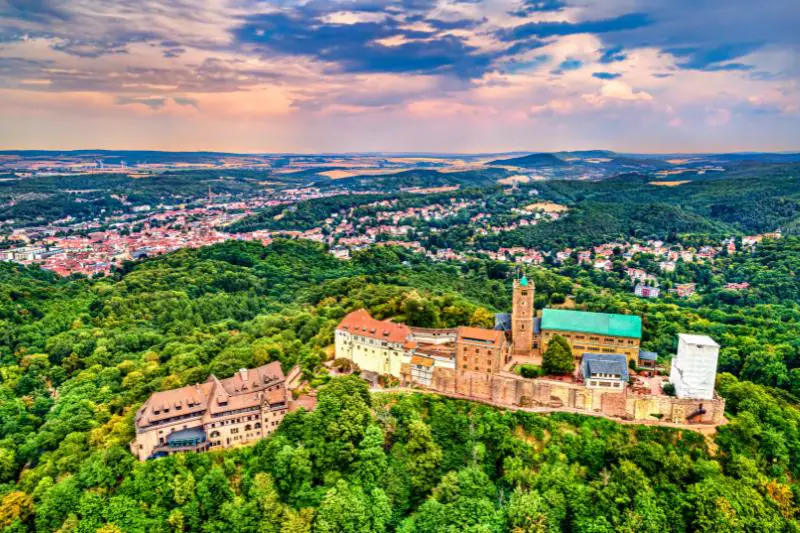
A day trip to Eisenach, less than an hour’s train journey from Erfurt, is an essential addition to any traveler’s itinerary looking to capture the spirit of German history and culture.
Eisenach is most renowned as the home of Wartburg Castle, a UNESCO World Heritage site where Martin Luther translated the New Testament into German, profoundly shaping the future of Christianity and the German language. It’s an amazing place to visit and do a tour.
History enthusiasts will revel in the town’s well-preserved architecture and the Bach House, where you can immerse yourself in the life and music of the legendary composer Johann Sebastian Bach who was born in this very house. Nature lovers can venture into the lush surroundings of the Thuringian Forest for hiking or simply taking in the scenic landscapes.
Meanwhile, automotive fans can’t miss the opportunity to visit the Automobile Welt Eisenach museum, celebrating the region’s contribution to car manufacturing.
The seamless journey from Erfurt to Eisenach, with regular train services linking the two towns, means that you can step back in time within the imposing walls of the Wartburg Castle or wander the leafy pathways once trodden by Bach and Luther, all with the convenience of a short return trip to Erfurt in time for dinner.
Click here to read our full guide to Eisenach.
16. Mühlhausen

Nestled within the lush, green heart of Thuringia, a day trip to Mühlhausen offers a delightful escape to a town rich in medieval history and charm. An easy 45-minute train ride from Erfurt, Mühlhausen greets you with an impressive array of historical structures, including well-preserved city walls and a skyline punctuated by numerous church spires, earning it the nickname “City of Towers.”
Mühlhausen’s fascinating past as a once-powerful member of the medieval Hanseatic League is still evident today as you wander through its cobbled streets. The town’s highlight is the 13th-century Divi-Blasii church, where the great Johann Sebastian Bach once served as an organist.
The Müntzer Memorial at St. Marien, commemorating the preacher Thomas Müntzer, provides insight into the turbulent times of the Peasants’ War. One upon a time, a lot happened here!
It’s a lovely place to just wander and the prettiest Old Town by far of the day trip options here. There are many half timbered houses and more – it’s everything I love about a German Old Town.
Historic sites, coupled with quaint cafés and local shops, make Mühlhausen a charming retreat for history buffs and casual explorers alike. Accessible, intriguing, and picturesque, Mühlhausen is an inviting complement to the cultural experience of anyone visiting Erfurt.
Click here to read our full guide to Mühlhausen.
Where To Stay In Erfurt
There’s a solid range of hotels in Erfurt and you won’t have problems finding somewhere to stay.
I decided to stay at Pension Neuerbe as it’s a short walk from both the Old Town and the train station (for all my day trips) and had apartment-style accommodation for a great price.
Pension Neuerbe

It took me eleven minutes to walk to Pension Neuerbe from the train station, and I was soon in my studio apartment. Thankfully, it was only one floor up as there are no elevators.
The main part of my room was as pictured above – a big bed, a desk area with two chairs and there was also a small book shelf complete with German books and a smaller television mounted on the wall. There was a big cupboard with some extra bedding. Unfortunately, it wasn’t the cleanest.
The kitchen area seemed fully equipped, with pots, pans, cutlery and crockery. There was also a decent sized fridge and the washing machine. The bathroom came off here with shower, toilet and basin.
There aren’t any facilities at this hotel and no reception. Someone was waiting outside to check me in, and check out simply involved leaving my key in the door. Easy!
It was quiet, comfortable and a great bargain. My only complaint is that the washing machine’s spin cycle didn’t work so I was stuck with a pile of soaking wet clothes with nowhere good to hang them. Otherwise, I loved my stay here.
Click here to see the latest prices now.
How To Get To Erfurt
Venturing to Erfurt, the capital of Thuringia, is an excursion into the heart of Germany’s cultural and historical splendor. Regardless of where you’re starting your journey in Germany, getting to Erfurt is straightforward and comfortable.

If you’re setting off from major cities such as Berlin, Munich, Frankfurt, or Hamburg, direct train services are at your disposal. Deutsche Bahn, Germany’s national railway company, offers efficient ICE (Intercity-Express) and regional trains that whisk travelers across the country to Erfurt’s Hauptbahnhof, the main train station nestled near the city center.
Let the train glide through the scenic German countryside while you enjoy amenities like free Wi-Fi and onboard dining. Booking your tickets online in advance often secures you the best deals and ensures a seamless travel experience.
Click here to check out Deutsche Bahn schedules and prices.
Preferring the autonomy of a road trip? Germany’s Autobahn network leads you to Erfurt with ease. The A4 is the primary motorway connecting the city to the east-west axis, while the A71 and A73 serve the north-south travelers. Rent a car from any major city and journey through the German lands at your own pace.
Click here to check out car hire options and prices.
Coaches offer a budget-friendly alternative for your exploration. Companies like FlixBus run regular services to Erfurt from many German cities with comfortable seats and free Wi-Fi. It might take a bit longer than the train, but the savings could be worth your while.
Upon arrival in Erfurt, you’ll find the old town just a short stroll away from the central station.

Final Words
Erfurt offers a sublime blend of medieval charm and contemporary culture, with activities and sights that cater to history buffs, nature lovers, and modern travelers alike. Its well-preserved architectural treasures, like the Gothic masterpiece of the Erfurter Dom, and the quaint appeal of Krämerbrücke, make it a must-visit destination for anyone seeking to step back in time while enjoying the comforts of the present.
As you wander through the cobbled streets, indulging in regional specialties, or basking in the serenity of the Egapark, remember that Erfurt is a city that thrives on its ability to embrace the new without forsaking its storied past.
Whether your journey here is for leisure, cultural enrichment, or simply to experience the unique charm of Thuringia’s capital, Erfurt promises a memorable adventure that will beckon you to return. It’s one of my personal favorite places in Germany.
Read our itinerary for Central Germany here which includes Erfurt. Find guides to nearby Kassel here and Weimar here. Find more guides to Central Germany here.

